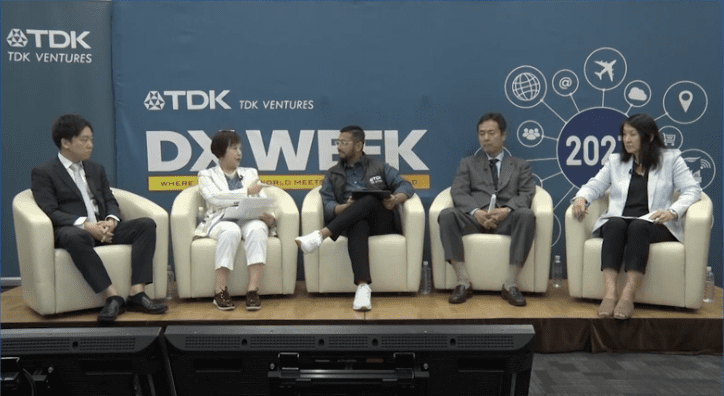All Demographics Benefit from Self-driving Electric Trucks and Buses
Environmental concerns and government policies herald a shift in mobility over the next decade. McKinsey & Company predicts that by 2035 there will be far fewer than the 1.3-billion privately owned cars in the world, as the world unites to combat air pollution, global warming, and traffic jams. To get there, however, public transportation, cargo delivery, and convenient available mobility solutions will have to improve dramatically. Top minds from the automotive, intellectual property, and industrial-research industries participated in a panel discussion to explain how it will happen. The event wrapped up the Tokyo portion of TDK Ventures’ 3-day Digital Transformation Week 2023.
Panel moderator Anil Achyuta, TDK Ventures Managing Director, began the conversation by noting that Nomura Research Institute, the largest economic research and consulting firm in Japan, predicts that by 2030, delivery-driver shortages and other logistical challenges will result in up to 35% of Japan’s cargo going undelivered.
“After Covid-19, we have recognized that logistics and commercial vehicles will be needed more and more in Japan,” said Kozue Nakayama, outside director of Isuzu Motors Limited. “There are many social problems here: an aging society, depopulation, and centralization. We have three major cities in Japan, and population and prosperity are focused on those main cities.” To solve the commercial and over-the-road driver shortage, “we need constant cooperation across sectors, including local government, automakers, IT, and urban design companies,” she added.
She outlined one such collaboration her company is involved with in Fukushima, site of the March 2011 earthquake, tsunami, and nuclear disaster. Isuzu’s joint venture with Toyota and Hino Motors aims to help the prefecture accelerate its resurgence. Namie, a town of about 20,000 before the disaster, remained uninhabited until after 2016. Slowly, residents returned, and about 2,000 live there now.
Nakayama said the goal is to make logistics more efficient, so they can support a hydrogen-fuel-based society. In Namie, the companies are mobilizing small, fuel cell-powered commercial trucks to transport green hydrogen produced in the region. The partners believe that building the hydrogen infrastructure and ecosystem will reduce carbon emissions while also supporting their efforts to solve the driver shortage by bringing efficiencies to delivery routes and eventually implementing autonomous driving to the trucking industry.
“I don’t know how to solve all the world’s problems,” Nakayama said, “but in this case, ‘street smart’ — connected, automated, shared, electric solutions developed through trial and error — is key. ADAS (advanced driving assistance systems) are a part of that solution. Convenience for the customer and efficiency for the supplier are always opposite. ADAS helps with efficiency, but customer efficiency is complicated. Place by place, demand is different. ADAS can help with some of the problems in the city at this moment just to support the efficiency of workers could be supported, but it is not a full solution.”
TIER IV, Inc., a deep-tech startup based in Japan, is also exploring business models and use cases involving autonomous driving for commercial trucks and public transportation.
Company Founder, CEO, and CTO Shinpei Kato said TIER IV will be ready to test self-driving vehicles in limited and controlled environments by the end of the year.
“In our long-term proof-of-concept project, we have found a lot of issues and solutions to move forward (with autonomous driving) for heavy vehicles in levels 2, 3, and 4,” he explained.
He said similar classes of technology can be employed for both driver assistance and self-driving systems, even though regulations and loads are completely different.
“Level 2 and Level 3 keep humans in the loop,” he explained. “Human/machine interaction is more significant than just automated functions. In Level 4, everything must be handled by machine. The most significant finding over the last five years is that if we can define a condition, including environment, weather, and all the other details, for (intelligent) vehicles to operate, the government is now willing to issue a road permit.”
The panelists agreed that value capture likely will change to enable mobility and autonomy to play out and to support the evolution to a service- and experience-based mobility industry.
“For Japanese companies, it is a weakness to make a defect standard,” Nakayama stated. “The winner could make one and could build a new ecosystem. This is very important from the commercial vehicle point of view. If we recognize the Big Three social problems, we can change society. This is a big opportunity for us. A mindset change will be needed. Look past the successes (we’ve had) as we jump into a new (paradigm).”
To accomplish that, according to Hiroko Osaka, head of Asian marketing for LexisNexis Intellectual Property Solutions, innovation is key.
“If you really are innovative, you actually have to deal with many different ideas and opinions, and ways of doing things,” he said. “The Japanese should accept more diverse (inputs). Finding ways for all of us to work together is the Japanese way, and it should continue.”
Panelists also reviewed the role human/machine interaction will play in delivering fully autonomous vehicles to improve mobility options for all segments of the population. And they talked about how software and intellectual property issues are shifting to accommodate more stakeholders in the progression toward energy and transportation improvements. We will cover these comments in future blogs.
The second annual TDK Ventures DX Week brought together some of the world’s brightest talent in the digital space. Held over three days in three global technology hubs — Silicon Valley, Tokyo, and Bengaluru — the panels, interviews, and lectures centered on the nexus between the analog and digital environments. The most prestigious thought-leadership event of the year, DX Week 2023 highlighted the insights, best practices, and visions that will guide digital technologies toward creating a more productive, inclusive, and sustainable planet.

